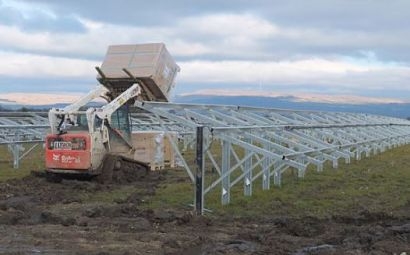
The solar farm will be able to supply around 50,000 households with environmentally friendly energy through its annual yield of 180 million kilowatt hours of electricity, saving about 129,000 tonnes of CO2 each year. The entire project is due to be commissioned before the end of 2020.
“Major photovoltaic projects like this one are just what is needed to push forward renewable energies and the Energiewende in Germany” said Dirk Güsewell, Head of Generation Portfolio Development at EnBW. “This solar park is our first renewable project without state funding. It also marks a milestone for photovoltaics in Germany and demonstrates that this technology has achieved market maturity.” This is possible because of synergy effects due to the size of the park and the fact that costs in the photovoltaic sector have fallen by more than 80 percent in the last ten years”.
Jörg Steinbach, Minister for Economic Affairs, Labour and Energy in Brandenburg, added that Brandenburg is taking a leading role in the Energiewende because hardly any other German state has pushed forward with the expansion of renewable energies so strongly and that EnBW is contributing to the achievement of its climate policy targets with projects such as the Weesow-Willmersdorf solar park demonstrating that renewable energies can be competitive.
More than 40 companies have been commissioned by EnBW to work on the construction of the solar farm.
The electricity will be fed into three 110 kilovolt overhead cables operated by E.DIS Netz GmbH. Two new transformer stations will be built to the west and southwest of the park in close vicinity to the high-voltage lines. EnBW is currently laying seven kilometres of cables to the planned transformer station to the southwest of the solar farm in the district of Blumberg. The almost 4-kilometre long connection to the planned transformer station to the west of the park near Börnicke will be completed later.
The around 465,000 solar modules will face south, have a construction height of around three metres and will be installed at an inclination of 20 degrees to the supporting structure. They will be distributed across four solar fields, divided by the local road network which will still be publicly accessible.
The solar power plant has a planned service life of 40 years. This is why EnBW has selected very high-quality, durable components and will ensure that comprehensive quality assurance measures are implemented throughout the entire service life of the park.
Ecological supervision commissioned especially for this project will ensure that all construction work is completed in harmony with the local flora and fauna and especially that the Weesower Luch nature reserve located to the south of the solar farm remains protected.
Alongside the actual technical facilities, the project also includes numerous compensatory and replacement measures for the protection of species and nature. For example, the entire area on and around the solar farm will be turned into a grassland habitat for a rich variety of species. As well as extensifying the project areas, the measures will include planting shrubs and trees and also developing hedges and stepping stone biotopes, which will complement the natural habitat found in the neighbouring nature reserve.
EnBW plans to place the solar farm into operation in construction stages.
For additional information:

